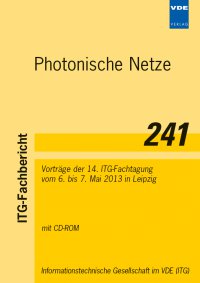Optical Nyquist-pulse generation with a power difference to the ideal sinc-shape sequence of < 1%
Konferenz: Photonische Netze - Vorträge der 14. ITG-Fachtagung
06.05.2013 - 07.05.2013 in Leipzig, Germany
Tagungsband: Photonische Netze
Seiten: 5Sprache: EnglischTyp: PDF
Persönliche VDE-Mitglieder erhalten auf diesen Artikel 10% Rabatt
Autoren:
Schneider, Thomas; Soto, Marcelo A.; Alem, Mehdi; Thévenaz, Luc (EPFL Swiss Federal Institute of Technology, Group for Fibre Optics (GFO), SCI-STI-LT, Station 11, 1015 Lausanne, Switzerland)
Shoaie, Mohammad Amin; Vedadi, Armand; Brès, Camille-Sophie (EPFL Swiss Federal Institute of Technology, Photonic Systems Laboratory (PHOSL), SCI-IEL, Station 11, 1015 Lausanne, Switzerland)
Inhalt:
Sinc-shaped Nyquist-pulses possess a rectangular spectrum. Thus, a sinc-pulse transmission minimizes the carrier spacing down to the baud rate, and therefore, substantially increases the transmissible data rates. These perspectives have led to a strong research activity in the field of Nyquist pulse transmission. However, all methods of Nyquist pulse generation shown up to now are rather complex, costly and none leads to ideal sinc-shaped Nyquist pulses. Thus, it has not been clear yet if Nyquist-pulse transmission can be incorporated in optical networks in an energy and cost-effective way. Here we present a method for the generation of almost ideal sinc-shaped Nyquist pulses based on a flat and phase-locked frequency comb. The pulses can be generated with conventional modulators without any sophisticated electronics or other costly equipment. In our proof-of-concept experiment we generate sinc-shaped Nyquist-pulse sequences which show a power difference lower than 1% compared to an ideal sequence. Generated sinc pulses have a full width at half maximum (FWHM) duration of 9.8 ps, an out-of-band suppression of more than 27 dB, a signal-to-noise ratio of more than 40 dB and a jitter of 82 fs, equivalent to 0.82% of the FWHM. The pulse width and repetition rate can be changed simply by tuning the comb parameters.


